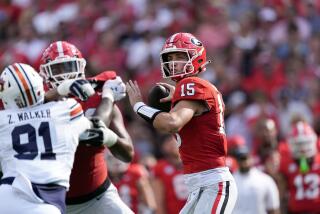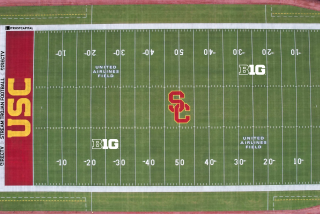SDSU Expects Windfall From NCAA Payment Plan
SAN DIEGO â The San Diego State athletic department, struggling to keep its budget out of the red, likely will get a boost of $183,535--and possibly as much as $254,535--thanks to the new method of cash distribution announced earlier this week by the NCAA.
The NCAAâs formula to disburse $69.9 million of its income from its new seven-year, $1 billion contract with CBS will reward schools with broad-based athletic programs.
The plan, which NCAA Associate Executive Director Lou Spry said figures to be approved at a December meeting of the NCAA Executive Committee, is designed to spread the wealth among all Division I schools, not just those that perform well in the NCAA basketball tournament.
As such, schools offering more than 12 varsity sports--the minimum required for membership in Division I--will receive money.
Don Kaverman and Jim Herrick, SDSU associate athletic directors, spent the week breaking down NCAA reports and said they expect the school to receive before next September:
--$124,410 for having 189 scholarships.
--$34,125 for offering 17 different sports programs.
--$25,000 for academic enhancement, a sum each Division I school will receive.
--A share to be determined of the Western Athletic Conferenceâs take from the Division I basketball tournament.
Some of these numbers will likely fluctuate, and the estimates are based on scholarship and sports offerings in March, 1989. The NCAA has earmarked $31.25 million for distribution through a scholarship and sport offerings formula and another $31.25 million for distribution to conferences for participation in the basketball tournament. The remaining $7.4 million will be distributed for academic enhancement in equal $25,000 parcels to each of the 296 schools.
How much will SDSU receive from the NCAA basketball tournament? If the WAC decides to divide its share ($948,276) evenly among the nine member schools, that could mean about $100,000 for SDSU. At the very least, SDSU probably will receive more than the $28,650 it got last year.
The NCAA will dole out the basketball tournament money in April, the academic enhancement money in June and the broad-based money in August. Each increment will arrive in one lump sum.
âTheyâre spreading the wealth, which is what they really need to do,â Kaverman said.
This method seems to encourage schools to add varsity sports. Under the NCAAâs plan, a school receives $6,825 for each sport it sponsors over 12. That dollar figure is slightly under SDSUâs budget for the menâs golf team ($8,000) and far more than the budgets for the menâs and womenâs cross country teams ($3,250 each). Plus, SDSU gets more money for each full scholarship offered.
âIt almost pays to sponsor a sport because youâre going to get money from the NCAA to run it,â Kaverman said. âThe same thing goes for grants-in-aid. And the more money a program has, the more grants-in-aid it can afford to offer. . . .â
Said Spry: âIt was the intent of the committee that you shouldnât receive something just for meeting the minimum. You should be over and above the minimum.
âI think because of the way the payments are structured, it encourages an institution to sponsor more sports and give more grants-in-aid.â
Fred Miller, SDSU athletic director, is on vacation in France and will not return until next week, so there has been no decision made as to whether SDSU will consider adding sports.
âItâs possible,â Kaverman said. âThe NCAA is trying to encourage (adding sports) while controlling costs and time demands. Just because you add a sport doesnât mean you have to spend a lot of money.â
The NCAA has established minimum standards in each sport to prevent a school from adding one just to receive an extra $6,825. In tennis, for example, a school must have a minimum of five participants in 12 contests. In golf, a school must have no fewer than five golfers in at least eight contests.
âIf there are three golfers (that participate in one tournament), weâre not going to pay off,â Spry said. âThere has to be a legitimate number of contests and participants.â
As for the basketball tournament money, the NCAA will give each conference a lump sum to divide among its member schools. The payment to each conference will be based on a rolling six-year average of how that conferenceâs teams fared in the basketball tournament during that time. Each game played will count as one unit, and each unit is worth about $43,000.
This will eliminate the large single-game payoffs of the past. For example, in the 1990 tournament a first-round game was worth about $294,500, according to Spry.
âI used to live and die with those games, (for) BYU (to beat) Clemson,â said Herrick, who handles the athletic departmentâs business affairs. â âWe need this money, Donât blow this free throw.â It behooves us and our conference to succeed in the tourney, but itâs not directly correlated anymore. If Texas El Paso wins the tourney next year and two other WAC schools go to the Final Four, normally that would provide a tremendous windfall. Now, it wonât. In a six-year sliding scale, it wonât make that big of a difference.â
Said Spry: âYou donât get well by somebody going to the finals. But you donât get hurt as bad when they donât. It tends to level out the amount of money a conference will receive.â
The NCAA has computed how much each school will receive this season based on the six-year period 1985-1990. WAC teams made 22 appearances in that time, so the conference will receive $948,276.
The NCAA Revenue Advisory Committee stopped short of requiring each conference to divide the money equally among its members, although the committeeâs report called it an âexpectation.â
However, the WACâs current formula for NCAA tournament revenue distribution is not so balanced. It rewards the participating school with more than 50% of the conferenceâs tournament revenue, with remaining conference members and the league itself getting equal shares of the remainder.
WAC athletic directors are scheduled to meet Dec. 11 to discuss whether to keep their current revenue-sharing formula, and SDSUâs Herrick said he hopes Miller will lobby for the equal-shares approach.
âIf weâre satisfied, fine,â WAC Commissioner Joe Kearney said. âIf we need to fine-tune it, what type of fine-tuning do we need? If there are some areas of dissatisfaction, what are they?â
Kearney said this meeting will take place specifically to discuss the changes in NCAA distribution and the financial bonanza.
Either way, SDSU should benefit. If the current system is maintained, SDSU will benefit because the Aztecs played a first-round NCAA tournament game in 1985, an 85-80 loss to Nevada Las Vegas, so the school will receive more than the three WAC schools--Air Force, Utah and Hawaii--that failed to make an NCAA tournament appearance during that time.
If the WAC alters its methods, it will likely make things more equitable, which would also benefit SDSU. If the WAC decides to split its take from this yearâs tournament equally, SDSU could receive about $100,000, roughly a $71,000 increase from last yearâs sum. SDSU received $28,650 from the 1989-90 NCAA basketball tournament.
âThe NCAA is not mandating that conferences split (the money equally), but thatâs certainly what theyâre implying,â Kaverman said. âThe idea is to make sure that Northwestern and Wisconsin get as much as Michigan and Indiana. Thatâs part of the benefit of belonging to a conference.â
The NCAA calls the plan âequitable, but not equal.â It will go to the NCAA Executive Committee on Dec. 3 for final approval.
âAt the present time, based on the calls I and others here have had, we donât think there is any widespread resentment or disagreement with the proposal,â Spry said. âIâve talked to a few conferences, and other people here at the office have had the same kind of conversations, and weâre not hearing, âOh my God, thatâs awful.â Naturally, there is a certain amount of âI wish we were doing this and not thatâ, but weâre trying to please 296 Division I colleges and universities and 33 conferences. Thatâs a tall order.â
DIVVYING UP CBSâS MILLIONS
Revenue distribution for the top 10 conferences under the NCAAâs projected dispersal of $69.9 million from the NCAA Division I basketball tournament:
Broad-based Basketball Academic Total CONFERENCE Distribution Distribution Enhancement Distribution BIG TEN $3,370,601 $3,491,379 $250,000 $7,111,980 ACC $2,170,861 $3,965,517 $200,000 $6,336,378 BIG EAST $1,277,259 $3,793,103 $225,000 $5,295,362 SOUTHEASTERN $2,021,458 $2,413,793 $250,000 $4,685,251 BIG EIGHT $1,536,622 $2,500,000 $200,000 $4,236,622 PAC 10 $2,416,663 $1,293,103 $250,000 $3,959,766 SOUTHWEST $1,505,847 $1,206,897 $225,000 $2,937,744 ATLANTIC 10 $1,685,283 $905,172 $250,000 $2,840,455 WAC $1,367,211 $948,276 $225,000 $2,540,487 MID-AMERICAN $1,778,933 $474,138 $225,000 $2,478,071 Total $31,250,000 $31,250,000 $7,400,000 $69,900,000
In column 1, broad-based distribution includes money based on scholarships and varsity sports offered. Grant Nos. 1 through 50 will earn a school $87 for each scholarship; Grants Nos. 51-100, $174 each; Grants Nos. 101-150, $870 each; Grants Nos. 151-200, $1,740 each; Grants Nos. 201-250, $2,610 each; Grants Nos. 251 and above, $3,480 each. For varsity sports offered, a school will receive $6,825 for each sport over 12.
In column 2, the basketball distribution includes money based on a rolling, six-year average of a conferenceâs representation and success in the NCAA basketball tournament. A conference gets one unit for each game played by one of its member schools, and each unit is worth about $43,000.
In column 3, the academic enhancement includes an automatic $25,000 paid to each of a conferenceâs member schools.
More to Read
Go beyond the scoreboard
Get the latest on L.A.'s teams in the daily Sports Report newsletter.
You may occasionally receive promotional content from the Los Angeles Times.










